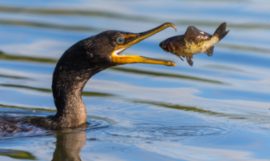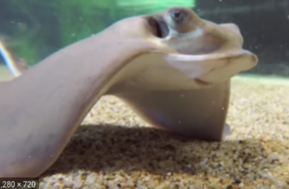'there's more wildlife than the eye can see over Merritt’s water, and there's more than birds below its surface'--ynez foxe-robertson, 7th grade

Lake Merritt is an amazing place in Oakland that is famous for many things, including Fairy Land, pollution, and birds. Lake Merritt’s history goes back to Samuel Merritt, a mayor of Oakland, 1871. Merritt made a large impact on Lake Merritt, and when he was mayor, created a bird sanctuary at the lake, which was the first lake safe from hunting and fishing, in California. But there's more wildlife than the eye can see over Merritt’s water, and there's more than birds below its surface.
Double Crested Cormorant:
The double crested cormorant is a sleek black bird, with a yellow beak, that is turned down at the end. Cormorants have a habit of spreading out their wings to dry after they have dived under the water to grab fish in their hooked beaks. Cormorants are all around the west coast year round, and are also found on the Gulf of Mexico, Florida, and also on the Atlantic coast.
Double Crested Cormorant:
The double crested cormorant is a sleek black bird, with a yellow beak, that is turned down at the end. Cormorants have a habit of spreading out their wings to dry after they have dived under the water to grab fish in their hooked beaks. Cormorants are all around the west coast year round, and are also found on the Gulf of Mexico, Florida, and also on the Atlantic coast.

Snowy Egret:
Snowy egrets are undoubtedly, one of the most beautiful herons to ever have lived. They have mostly black legs with yellow feet, (this results in them looking like yellow boots) and striking white feathers. Males sometimes have puffed white heads. Early conversationalists tried to protect snowy egrets, with a rally, in the early twentieth century. They succeeded, and the snowy egret is now once again, a common, and beautiful sight in the twenty-first century.
Snowy egrets are undoubtedly, one of the most beautiful herons to ever have lived. They have mostly black legs with yellow feet, (this results in them looking like yellow boots) and striking white feathers. Males sometimes have puffed white heads. Early conversationalists tried to protect snowy egrets, with a rally, in the early twentieth century. They succeeded, and the snowy egret is now once again, a common, and beautiful sight in the twenty-first century.

Bat Ray:
Yes, that is right, there are bat rays in Lake Merritt, though smaller than sting rays, and lots smaller than the infamous manta rays, they are still an amazing sight to see in your local lake. These strange and peculiar animals got here through a channel, from the San Francisco Bay. Bat rays have a cartilage skeleton, which basically means they're floppy and instead of bones, their skeleton is made out of cartilage, which helps them slip easily through the cracks of the channel's grate. But the fact that these animals got here, and managed to survive, is a great sign that the lake is getting less polluted than it was a few years ago.
Yes, that is right, there are bat rays in Lake Merritt, though smaller than sting rays, and lots smaller than the infamous manta rays, they are still an amazing sight to see in your local lake. These strange and peculiar animals got here through a channel, from the San Francisco Bay. Bat rays have a cartilage skeleton, which basically means they're floppy and instead of bones, their skeleton is made out of cartilage, which helps them slip easily through the cracks of the channel's grate. But the fact that these animals got here, and managed to survive, is a great sign that the lake is getting less polluted than it was a few years ago.

Leopard Shark:
SHARK is what you're probably thinking once you read that singular word, and yes, I know, it’s a little bit eerie to think that Lake Merritt has long leopard sharks swimming in its deep and dark depths. So maybe you’ll be happy to know that they mostly hang out in one particular spot near the Lake Merritt restaurant, The Lake Chalet. Leopard sharks are cold water fish, so they would likely die in tropical water, above 70 degrees ℉.
SHARK is what you're probably thinking once you read that singular word, and yes, I know, it’s a little bit eerie to think that Lake Merritt has long leopard sharks swimming in its deep and dark depths. So maybe you’ll be happy to know that they mostly hang out in one particular spot near the Lake Merritt restaurant, The Lake Chalet. Leopard sharks are cold water fish, so they would likely die in tropical water, above 70 degrees ℉.

California Brown & White Pelican:
California brown pelicans have always been at Lake Merritt, but the white pelicans are somewhat newer and rarer to the lake’s history. It’s absolutely breathtaking, to watch a pelican plunge from 10 to 20 feet, to catch a fish they spot from above. Pelicans are plunge divers, which means what it sounds like, they dive or plunge into the water, to catch their meals. As they get their food, they truly look like a missile shooting down into the water, only to return to the surface, with a large flapping fish in their greatbills. The trademark pelican bill may be the thing that defies them the most, you can always identify them by looking at their long beak. White pelicans are usually a bright white color, their wings with harsh lines of black, and a bright yellow bill, with an odd large or small bump near the end. While brown ones have many different colors, like brown, black, or even red, on their feathers, with no bump on their beak at all.
California brown pelicans have always been at Lake Merritt, but the white pelicans are somewhat newer and rarer to the lake’s history. It’s absolutely breathtaking, to watch a pelican plunge from 10 to 20 feet, to catch a fish they spot from above. Pelicans are plunge divers, which means what it sounds like, they dive or plunge into the water, to catch their meals. As they get their food, they truly look like a missile shooting down into the water, only to return to the surface, with a large flapping fish in their greatbills. The trademark pelican bill may be the thing that defies them the most, you can always identify them by looking at their long beak. White pelicans are usually a bright white color, their wings with harsh lines of black, and a bright yellow bill, with an odd large or small bump near the end. While brown ones have many different colors, like brown, black, or even red, on their feathers, with no bump on their beak at all.
we all know that lake Merritt is a beautiful scene to look at, and we also know that lake Merritt is extremely polluted, and even though its slowly getting better, we still need to know what we need to do to make it swimmable (or close to swimmable) so our lake can be safe.


